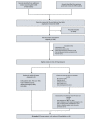Association Between Patient Factors and the Effectiveness of Wearable Trackers at Increasing the Number of Steps per Day Among Adults With Cardiometabolic Conditions: Meta-analysis of Individual Patient Data From Randomized Controlled Trials
- PMID: 36040779
- PMCID: PMC9472038
- DOI: 10.2196/36337
Association Between Patient Factors and the Effectiveness of Wearable Trackers at Increasing the Number of Steps per Day Among Adults With Cardiometabolic Conditions: Meta-analysis of Individual Patient Data From Randomized Controlled Trials
Abstract
Background: Current evidence supports the use of wearable trackers by people with cardiometabolic conditions. However, as the health benefits are small and confounded by heterogeneity, there remains uncertainty as to which patient groups are most helped by wearable trackers.
Objective: This study examined the effects of wearable trackers in patients with cardiometabolic conditions to identify subgroups of patients who most benefited and to understand interventional differences.
Methods: We obtained individual participant data from randomized controlled trials of wearable trackers that were conducted before December 2020 and measured steps per day as the primary outcome in participants with cardiometabolic conditions including diabetes, overweight or obesity, and cardiovascular disease. We used statistical models to account for clustering of participants within trials and heterogeneity across trials to estimate mean differences with the 95% CI.
Results: Individual participant data were obtained from 9 of 25 eligible randomized controlled trials, which included 1481 of 3178 (47%) total participants. The wearable trackers revealed that over the median duration of 12 weeks, steps per day increased by 1656 (95% CI 918-2395), a significant change. Greater increases in steps per day from interventions using wearable trackers were observed in men (interaction coefficient -668, 95% CI -1157 to -180), patients in age categories over 50 years (50-59 years: interaction coefficient 1175, 95% CI 377-1973; 60-69 years: interaction coefficient 981, 95% CI 222-1740; 70-90 years: interaction coefficient 1060, 95% CI 200-1920), White patients (interaction coefficient 995, 95% CI 360-1631), and patients with fewer comorbidities (interaction coefficient -517, 95% CI -1188 to -11) compared to women, those aged below 50, non-White patients, and patients with multimorbidity. In terms of interventional differences, only face-to-face delivery of the tracker impacted the effectiveness of the interventions by increasing steps per day.
Conclusions: In patients with cardiometabolic conditions, interventions using wearable trackers to improve steps per day mostly benefited older White men without multimorbidity.
Trial registration: PROSPERO CRD42019143012; https://www.crd.york.ac.uk/prospero/display_record.php?RecordID=143012.
Keywords: cardiometabolic conditions; cardiovascular disease; diabetes; individual patient data; meta-analysis; obesity; steps/day; systematic review; wearable tracker.
©Alexander Hodkinson, Evangelos Kontopantelis, Salwa S Zghebi, Christos Grigoroglou, Brian McMillan, Harm van Marwijk, Peter Bower, Dialechti Tsimpida, Charles F Emery, Mark R Burge, Hunter Esmiol, Margaret E Cupples, Mark A Tully, Kaberi Dasgupta, Stella S Daskalopoulou, Alexandra B Cooke, Ayorinde F Fayehun, Julie Houle, Paul Poirier, Thomas Yates, Joseph Henson, Derek R Anderson, Elisabeth B Grey, Maria Panagioti. Originally published in the Journal of Medical Internet Research (https://www.jmir.org), 30.08.2022.
Conflict of interest statement
Conflicts of Interest: None declared.
Figures




References
-
- Laranjo Liliana, Ding Ding, Heleno Bruno, Kocaballi Baki, Quiroz Juan C, Tong Huong Ly, Chahwan Bahia, Neves Ana Luisa, Gabarron Elia, Dao Kim Phuong, Rodrigues David, Neves Gisela Costa, Antunes Maria L, Coiera Enrico, Bates David W. Do smartphone applications and activity trackers increase physical activity in adults? Systematic review, meta-analysis and metaregression. Br J Sports Med. 2021 Apr;55(8):422–432. doi: 10.1136/bjsports-2020-102892.bjsports-2020-102892 - DOI - PubMed
-
- Miranda JJ, NCD Risk Factor Collaboration (NCD-RisC)—Americas Working Group Trends in cardiometabolic risk factors in the Americas between 1980 and 2014: a pooled analysis of population-based surveys. Lancet Glob Health. 2020 Jan;8(1):e123–e133. doi: 10.1016/S2214-109X(19)30484-X. https://linkinghub.elsevier.com/retrieve/pii/S2214-109X(19)30484-X S2214-109X(19)30484-X - DOI - PMC - PubMed
-
- GBD 2015 Risk Factors Collaborators Global, regional, and national comparative risk assessment of 79 behavioural, environmental and occupational, and metabolic risks or clusters of risks, 1990-2015: a systematic analysis for the Global Burden of Disease Study 2015. Lancet. 2016 Oct 08;388(10053):1659–1724. doi: 10.1016/S0140-6736(16)31679-8. https://linkinghub.elsevier.com/retrieve/pii/S0140-6736(16)31679-8 S0140-6736(16)31679-8 - DOI - PMC - PubMed
-
- Physical activity. World Health Organization. [2022-07-03]. https://www.who.int/news-room/fact-sheets/detail/physical-activity .
-
- Physical activity. National Institute for Health and Care Excellence. 2020. [2022-07-03]. https://www.nice.org.uk/guidance/lifestyle-and-wellbeing/physical-activity .
Publication types
MeSH terms
LinkOut - more resources
Full Text Sources

